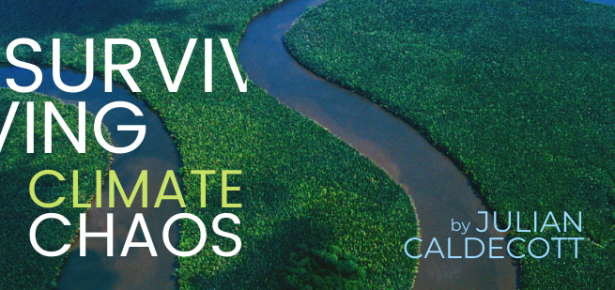
Surviving Climate Chaos is being published into a new world of lethal fires, floods and record-breaking temperatures, as well as frantic international negotiations before CoP 26 in Glasgow. This is while the IPCC warns us that we are in the last decade before Arctic, oceanic and equatorial tipping points take all choices out of human hands. This emergency calls for far greater focus and impact in our climate change response, and for the strengthening of communities and ecosystems everywhere against climate chaos
Adaptation.
Those working on the climate change response call ‘adaptation’ anything that makes human societies better able to cope with the effects of climate change. I wrote Surviving Climate Chaos mainly because there seemed to be great gaps in our understanding of how best to do this. Planning seemed to be working, more or less, at the macro level of predictable, large-scale phenomena like rising sea levels or changing rainfall patterns over large areas. That sort of thing can be handled by governments sharing satellite data and making top-down planning decisions, for example to harden coastlines against storms, or to stop people building houses on flood plains. But the response seemed weak and incoherent at the micro level of how communities respond to chaotic manifestations of change in their own local environments, which is what they actually have to live with. At that level, the issue is the strength of local systems to withstand, bounce back from or accommodate near-random shocks from an unstable climate. My book therefore seeks answers to the question of where do these kinds of strength come from, and how to safeguard and build them quickly in millions of localities?
Communities and ecosystems.
I started with understanding communities as human social systems: people living in a place and sharing a past, a language, a culture, an economy, and a relationship with their environment. The phrase ‘more or less’ needs to be inserted there, since people are so diverse, mobile and urban, and fewer people than before live in purely ‘traditional’ societies. Still, as I point out, people tend to gravitate together, to relate to one another and to where they live, and quickly to adopt local ways of doing things. One take-home from my book is that enabling community solidarity is easy, because it builds on the natural sociability of our species. Another is that it is also both very cheap and very useful as a way for larger society to strengthen itself against climate chaos. But a third is that to be strong a local society has to have a healthy relationship with its ecology, and that you can’t have sustainability if you separate the security of local people from the security of local ecosystems. In the book I assemble a lot of evidence from aid projects that involved strengthening community-ecosystem bonds in Nepal, Bolivia and Zanzibar. I also report on my search of the official adaptation strategies of 158 countries for evidence that this approach is being followed. The results are encouraging: a third of countries are already doing community-based and ecosystem-based adaptation, or intend to.
Title: Surviving Climate Chaos by Strengthening Communities and Ecosystems
Author: Julian Caldecott
Paperback ISBN: 9781108793780
Hardback ISBN: 9781108840125
Latest Comments
Have your say!